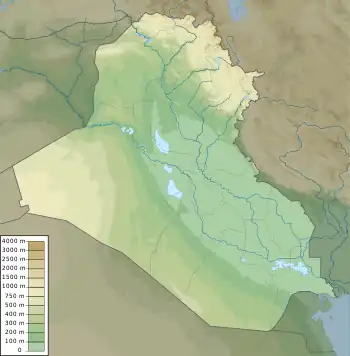| An-Nukhailah Mosque | |
|---|---|
Arabic: مسجد النخيلة | |
 The conical muqarnas dome built above the tomb of Ezekiel (or Dhu'l Kifl) | |
| Religion | |
| Affiliation | Islam |
| Rite | Shi'ite |
| Ecclesiastical or organisational status | Mosque and shrine |
| Status | Active |
| Location | |
| Location | Al Kifl, Iraq |
 Location in Iraq | |
| Geographic coordinates | 32°13′36″N 44°22′01″E / 32.2267908°N 44.3670540°E |
| Architecture | |
| Type | mosque |
| Style | Islamic architecture |
| Completed | 1316 CE |
| Specifications | |
| Dome(s) | 1 |
| Dome height (outer) | 20 metres (66 ft) |
| Shrine(s) | 3: Ezekiel's Tomb, Tombs of the Jewish saints, and spot of Al-Khidr |
An-Nukhailah Mosque (Arabic: مسجد النخيلة) is an historic Shi'ite mosque in the town of Al Kifl, Iraq. The mosque is a large complex built over a former Jewish site. The building contains the Dhu'l Kifl Shrine (Arabic: مرقد نبي الله ذي الكفل), which is believed to be the tomb of the prophet Dhul-Kifl, who is traditionally considered to be Ezekiel.
History
The complex was originally a pilgrimage site for Jews as it contained the tomb of the prophet Ezekiel, built back in the 7th century.[1] However, the belief by the Shi'ites is that the site has its roots on a shrine built by the prophet Abraham, indicated by the description of Imam al-Mahdi by Muhammad al-Jawad, the ninth of the Twelve Imams in the Twelver branch of Shia Islam.[2] In 1316, the Ilkhanid Sultan Öljaitü acquired the right of guardianship over the tomb, and his son Abu Sa'id Bahadur fully rebuilt the mosque.[3] Since then the site was restored, and renamed according to the Islamic tradition and developed as an Islamic religious site. The iconic minaret and the mosque were erected in the same period.[1]
In 2014, the site, especially the minarets, were restored by the Iranian companies and the Waqf of the Shi’a community, which cost approximately 800 million dinars.[4]
Architecture
The unique dome of the tomb has muqarnas adorned inside, and mimics the honeycomb pattern on the outside. The surface and the upper part of the wall is painted with polychrome pattern from the Ottoman period.[1] It reaches 20 metres (66 ft) high and sits on the foundation of 4 cubic metres (140 cu ft).[2]
The minaret is accessible through a small door. The body of the minaret is adorned with multiple forms of geometric decorations. It includes three fields of patterns, such as friezes and repeating belts, all of which are placed in a revolving manner around the body of the lighthouse. These decorations combine geometric shapes, plant outlines, Keffiyeh patterns and calligraphy in the style of Naskh script.[5] Persian inscriptions on the minaret and on the walls of the mosque are slightly visible, and they praise the founder of the mosque, the Ilkhanid ruler Muhammad Khudabandah.[6]
Next to the Tomb of Ezekiel is a hallway which contains the tombs of five Jewish saints on either side. The saints are believed to have either transmitted or compiled the Babylonian Talmud.[7] Their names are Rabbi Yose, Yehoshua, Yohanan, Baruch (whose grave is isolated from the others) and one of the Kohen priests, who is said to have been a transmitter of the Talmud.[8] A small shrine dedicated to Al-Khidr is also present within the mosque.[9]
To the left of the southern wall is a small commemorative spot which represents a place featured in a legend; it is said that it is where Ali ibn Abi Talib prayed while staying in the mosque on a campaign against the Kharijites.[10]
See also
References
- 1 2 3 Dhu'l Kifl Shrine. Archnet. Retrieved January 10, 2018.
- 1 2 مسجد النخيلة التاريخي. مركز التراث البصرة. Retrieved January 11, 2018.
- ↑ "مسجد النخيلة التأريخي". قسم شؤون المعارف الاسلامية والانسانية (in Arabic). Retrieved 2023-11-10.
- ↑ افتتاح منارة مسجد (النخيلة) التاريخي بالقرب من "ضريح الكفل" بعد تأهيلها بكلفة مليار و800 مليون دينار Archived 2018-06-21 at the Wayback Machine. Al-Mada Press. Retrieved January 11, 2018.
- ↑ "مسجد النخيلة التأريخي". قسم شؤون المعارف الاسلامية والانسانية (in Arabic). Retrieved 2023-11-10.
- ↑ "مسجد النخيلة التأريخي". قسم شؤون المعارف الاسلامية والانسانية (in Arabic). Retrieved 2023-11-10.
- ↑ "خشوع على ضفاف الفرات ." main.holyshrine (in Arabic). Retrieved 2023-11-10.
- ↑ "خشوع على ضفاف الفرات ." main.holyshrine (in Arabic). Retrieved 2023-11-10.
- ↑ "خشوع على ضفاف الفرات ." main.holyshrine (in Arabic). Retrieved 2023-11-10.
- ↑ "مسجد النخيلة التأريخي". قسم شؤون المعارف الاسلامية والانسانية (in Arabic). Retrieved 2023-11-10.
Bibliography
- Al-Janab Tariq Jawad (1982). Studies in Medieval Iraqi Architecture. Baghdad: Ministry of culture and Information, State Organization of Antiquities and Heritage. pp. 96–105.
- Michell, George, ed. (1978). Architecture of the Islamic World. London: Thames and Hudson. p. 246.
External links
- Official Website of An-Nukhailah Mosque
- INSIDE EZEKIEL SHRINE Archived 2019-01-09 at the Wayback Machine. Babylon Jews. Retrieved January 11, 2018.
